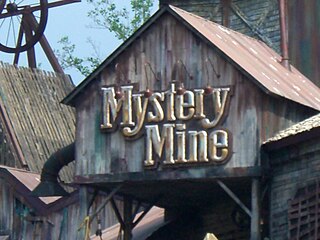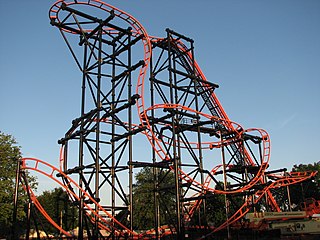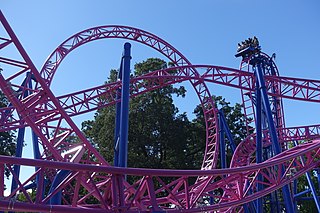
Twisted Colossus is a steel roller coaster located at Six Flags Magic Mountain in Valencia, California. Originally designed and built by International Amusement Devices, the roller coaster opened as Colossus, a dual-tracked roller coaster, on June 29, 1978. It was the tallest and fastest wooden roller coaster in the world and the first with two drops greater than 100 feet (30 m). Colossus became well known after appearances in film and television, including the box-office hit National Lampoon's Vacation and the made-for-TV movie Kiss Meets the Phantom of the Park. For 19 years, it was the park's main attraction until the opening of Superman: The Escape.

Goliath is a steel roller coaster located at Six Flags Magic Mountain amusement park in Valencia, California. Manufactured by Giovanola of Switzerland, the hypercoaster is located in the Goliath Plaza section of the park and opened to the public on February 11, 2000. Its sub-tropical theme is characterized by ancient ruins of the Mayan civilization. The ride is nearly identical to Titan at Six Flags Over Texas, but it lacks a 540-degree upward helix prior to the mid-course brake run and features a slightly shorter track layout.

Eejanaika (ええじゃないか) is a steel 4th Dimension Hypercoaster at Fuji-Q Highland in Fujiyoshida, Yamanashi, Japan. The ride was the world's second 4th Dimension coaster. Eejanaika is taller, faster, and longer than its predecessor, X2 at Six Flags Magic Mountain.

Orient Express was a steel roller coaster located at Worlds of Fun in Kansas City, Missouri. Introduced in 1980, the ride was manufactured by Arrow Huss and designed by Ron Toomer. It was replaced in 2004 by Spinning Dragons, a Gerstlauer spinning roller coaster. The red-orange track was located between the two entrances of the park. The station house was retained for use with a haunted attraction during the park's annual Halloween event.
NoLimits Roller Coaster Simulation is a software package available for Microsoft Windows and Mac OS X designed and built by a team of programmers and artists led by German programmer Ole Lange. It was first released in November 2001. The package includes two separate pieces of software, the NoLimits Editor and NoLimits Simulator, with a third application of the game, the NoLimits Terraformer supported as well.

The Legend is a wooden roller coaster at Holiday World & Splashin' Safari in Santa Claus, Indiana, United States. It was designed and built beginning in 1999 by the now defunct Custom Coasters International, with the help of designers Dennis McNulty and Larry Bill; it opened on May 6, 2000. The Legend is themed after Washington Irving's short story "The Legend of Sleepy Hollow" and mimics the frightful ride Ichabod Crane took as he was chased through the woods by the Headless Horseman. The Legend has been consistently ranked among the world's top twenty-five wooden roller coasters at the Golden Ticket Awards, which are presented annually by Amusement Today magazine.

Mystery Mine is a Gerstlauer Euro-Fighter model steel roller coaster located at Dollywood amusement park, in Pigeon Forge, Tennessee. The ride, highly themed as a defunct, haunted mining operation from the 19th century, was the single largest investment in Dollywood's history, costing US$17.5 million. Designed by German manufacturer Gerstlauer, Mystery Mine was installed by Ride Entertainment Group, who handle all of Gerstlauer's projects in the Americas.

Hollywood Rip Ride Rockit is a steel roller coaster at Universal Studios Florida in Orlando, Florida. With a height of 167 feet (51 m), a length of 3,800 feet (1,200 m), and a top speed of 65 miles per hour (105 km/h), it is the largest X-Coaster ever built by German manufacturer Maurer Söhne. Announced on March 19, 2008, the coaster officially debuted on August 19, 2009, despite original plans to open several months earlier in the spring. Hollywood Rip Ride Rockit features on-ride music LED lighting, and on-ride photos and videos captured from cameras mounted in each passenger row.

Intimidator 305 is a steel roller coaster located at Kings Dominion in Doswell, Virginia, United States. Manufactured by Intamin, Intimidator 305 opened to the public on April 2, 2010, as the park's fourteenth roller coaster. It is located in the Jungle X-Pedition section of the park near Anaconda on the former site of the Safari Monorail ride. Standing at 305 feet (93 m) tall and reaching speeds up to 90 mph (145 km/h), it is the second Giga Coaster to be built in North America, following Millennium Force at Cedar Point. The $25-million investment was the largest of any ride in park history. Themed to racing, the coaster is named after the late NASCAR driver Dale Earnhardt, who was commonly known as "The Intimidator".

Intimidator is a steel roller coaster built by Bolliger & Mabillard at Carowinds in Charlotte, North Carolina. The roller coaster is located in the Celebration Plaza section of the park. Intimidator is the thirteenth roller coaster installed at Carowinds and is located on the site of the former Carowinds River Adventure near the entrance of the theme park. It is currently one of the tallest, fastest and longest roller coasters in the Southeast with a 232-foot (71 m) lift hill, a top speed of 75 mph (121 km/h) and a track length of 5,316 feet (1,620 m). It was announced on August 26, 2009, and opened March 27, 2010. The roller coaster's name comes from the nickname of NASCAR driver Dale Earnhardt, whose estate licensed the use of the name.

Dare Devil Dive is a steel roller coaster at Six Flags Over Georgia. Designed by German company Gerstlauer, Dare Devil Dive is based on the company's Euro-Fighter model, and features a 95-foot (29 m)-tall vertical lift hill, a 95° first drop, three inversions and a top speed of 52 miles per hour (84 km/h). It is also the first Euro-Fighter to debut a new lap-bar restraint system, replacing the more common over-the-shoulder harnesses.

El Loco is a model of steel roller coaster manufactured by S&S Worldwide. The rides are characterised by a vertical or beyond-vertical drop, tight corners and abnormal banking. As of November 2013, there are six El Locos operating around the world.

HangTime is a steel roller coaster at Knott's Berry Farm in Buena Park, California. The Infinity Coaster was manufactured by Gerstlauer on the former site of Boomerang and Riptide. On opening, it had the steepest drop on a rollercoaster in California, at 96°. HangTime was also marketed by the park as the first Dive Coaster in California. It opened on May 18, 2018.

The TMNT Shellraiser is a steel indoor roller coaster at Nickelodeon Universe amusement park, within the American Dream Meadowlands shopping and entertainment complex, at the Meadowlands Sports Complex in East Rutherford, New Jersey, United States. The roller coaster is a Euro-Fighter model manufactured by Gerstlauer, and themed to the 2012 Teenage Mutant Ninja Turtles television series. It is the steepest roller coaster in the world with a vertical drop of 121.5 degrees. The TMNT Shellraiser has the same layout as Takabisha at Fuji-Q Highland in Japan, a previous record holder for world's steepest roller coaster.

Mystic is a steel roller coaster located at Walibi Rhône-Alpes in Les Avenières, France. The coaster marked the park's 40th anniversary as well as a headlining part of a decade-long, €25 million investment plan. The coaster was manufactured by Gerstlauer and traverses a total 1,886.5 feet (575.0 m) of track both forwards and backwards, at a top speed of 52.8 mph (85.0 km/h).

Wakala is a steel family roller coaster located at Bellewaerde near Ypres, Belgium. The coaster pays heavy homage to the Kwakwakaʼwakw natives of the Canadian Pacific Northwest. It is manufactured by Gerstlauer and is targeted at families, with two lift hills, a meandering layout, and a vertical spike rollback element.

Tiki-Waka is a steel family roller coaster located at Walibi Belgium in Wavre, Belgium. The Polynesian-themed coaster opened for the 2018 season as the headlining attraction in the newly re-themed Exotic World area, and kickstarted a multi-year, €100,000 expansion plan.

Adrenaline Peak is a steel roller coaster at Oaks Amusement Park, just south of Portland, Oregon. The ride replaced the Pinfari Looping Thunder coaster in the park's South End, which closed after the 2017 season. The coaster was manufactured by Gerstlauer and is one of their Euro-Fighter coasters, containing three inversions and a vertical lift hill.

Pégase Express is a steel family launched roller coaster at Parc Astérix in Plailly, France. The coaster opened to the public on June 11, 2017. It travels both forwards and backwards throughout the layout.


















